

Four years after their award-winning original soundtrack for Sofia Coppola’s The Virgin Suicides, Air won a third Victoire de la Musique award for its album Talkie Walkie. In addition to earning critical acclaim, it was also one of Air’s most popular albums.

By February 2005, electronic music had come a long way, especially for a genre that had sought to remain anonymous at the outset and had long struggled with a bad reputation. Air, Philippe Zdar, and Dimitri From Paris were awarded the Order of Arts and Letters by the French Minister of Culture, Renaud Donnedieu de Vabres. He might not have exactly been a fan, but the gesture was appreciated; while French Touch didn’t need any kind of recognition to conquer the world, the award was highly symbolic.
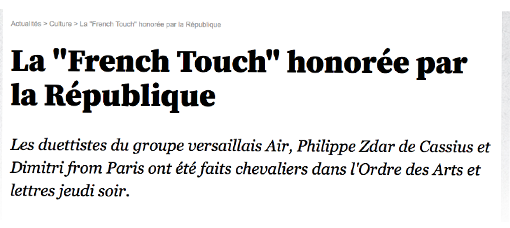
Article from Nouvel Observateur
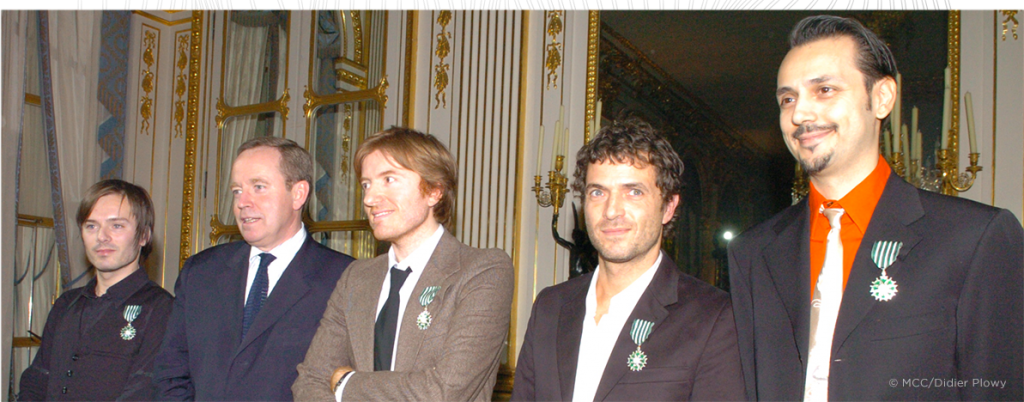
Jean-Benoît Dunckel, French Minister of Culture Renaud Donnedieu de Vabres, Nicolas Gaudin, Philippe Zdar, and Dimitri From Paris
Daft Punk received a rude awakening with their third album, Human After All, which disappointed both fans and the press. The CD was much less charming and accessible than their previous releases and revealed a harsher facet of the duo. Even though this third album is seen through a new lens nowadays, at the time it symbolized the end of the honeymoon period for French Touch and was never very successful.
The very first release of the Parisian record label Kill The DJ was a cover by Jennifer Cardini, who came out with a new version of Lio’s “Amoureux solitaires.” The moody, romantic track was the perfect fit for the new label, which sought to produce dance music that was both poetic and political. Kill The DJ was created in Pulp, a tiny club on Paris’s Boulevard Poissonière that, until it closed in 2007, was a meeting place for the underground scene. First and foremost, however, it was a girls’ club that was open to guys who “behaved themselves.”
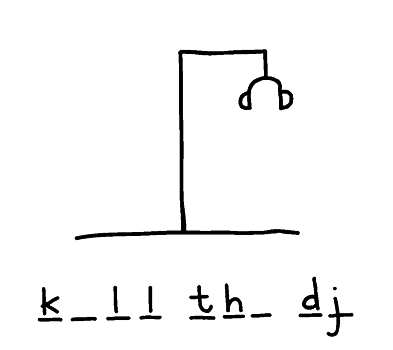
It was at this lesbian nightspot, which welcomed straight patrons as well, that Chloé, Ivan Smagghe, Fany Corral, and Stéphanie Fichard held Kill the DJ parties every Thursday night. Techno, rock, and new wave were played throughout the evening without any thought to tradition. A few year later, they decided to make vinyls that played the music they loved, be it techno, house, pop, or folk…nothing was off limits for the label, which simply signed the artists it enjoyed and didn’t hesitate to produce a wide variety of styles. Kill The DJ was a real success in the French electronic scene; even today, the label continues to rewrite the rules of the game both in terms of music and political activism. Kill The DJ, which is mostly managed by openly gay women, seeks to use its music to promote the most important values underpinning every party: sharing, acceptance, and exchange.
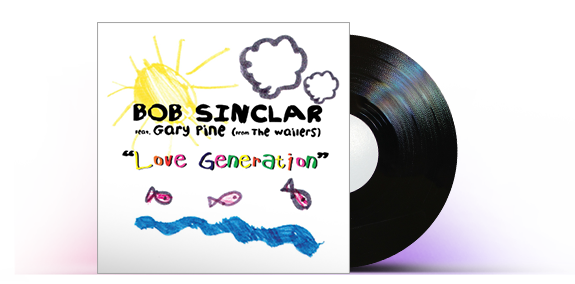
Christophe Le Friant, working under the pseudonym Bob Sinclar, the name of Belmondo’s character in The Man From Acapulco, was a French Touch pioneer who had always been open about wanting to reach the widest possible audience. After his first 1998 hit, “Gym Tonic,” which was as much a product of Thomas Bangalter of Daft Punk fame as himself, Le Friant finally achieved the level of international success he had always aspired to with “Love Generation,” a hit song featuring the vocals of Gary Pine. The track made its way into the living rooms of every French family when it was chosen as the theme song for a new reality TV show that had just come out, Star Academy.

Despite the venue’s miniscule size (it had a max capacity of 350 people), the opening of Paris Paris had a considerable impact on French electronic music. In just a few months, the tiny club became the meeting place for the latest generation of French Touch 2.0 DJs and the site of many memorable parties, including iPod Battles between Ed Banger and Institubes.
When Smash by the Parisian artist Jackson and His Computerband was released under the experimental English label Warp Records, the album didn’t sound like anything else in the French electronic music scene. His music pushed machines to their limits. Nowadays, the album is considered the missing link between French electronic music in the 1990s and the sound produced in the 2000s. He left his mark on Justice and other similar musicians, who readily cite him as a major influence on their work.

A wave of young rockers in boots and slim-cut jeans swept across France and Paris in particular, leaving in its wake a slew of new groups of underage (or just barely legal) musicians, including Naast, Shades, Second Sex, Plastiscines, and BB Brunes. However, a fringe group of young people decided to turn its back on the “return of rock.” Pharrell, Redhotcar, and Guillaume met online and decided to launch a new blog that contrasted sharply with the fashions of the time. Fluokids made a definite splash with its gaudy colors, brazen party photos, and electronic music. The blog’s music and lifestyle posts influenced an entire generation of teenagers determined to party to overdriven electro. Every day, the Fluokids band, which increased from three to seven members, posted new material from the house, techno, and pop scenes while also promoting Internet culture and a hedonistic lifestyle.

The movement started in France and spread throughout the world. Soon, young people everywhere were starting to dress in flashy, 80s-style clothing. The phenomenon affected music as well. Artists like Yelle, Klaxons, and Calvin Harris emerged alongside this new group of young people who preferred electro clubs to rock concerts. After an eight-year run, the Fluokids blog closed for good in 2013, carrying with it a technicolored breath of fresh air the MySpace generation won’t soon forget.
Ever since 2002, Kitsuné Maison had been shaking up the fashion world in Paris with its revolutionary concept—a clothing brand that also published records. Founded by the French-Japanese duo Masaya Kuroki and Gildas Loaëc, who had a long history of working with Daft Punk, for whom he managed the record labels Roulé and Cryadmoure, Kitsuné Maison alternated between releasing new clothing collections and records by young pop artists from around the world, including Hot Chip’s first album. In 2005, however, they decided to put together a compilation of young pop and electronic artists that would be released at regular intervals like a fashion collection. With its very first Kitsuné Maison Compilation in 2005, the duo got ready to break into the new French Touch 2.0 scene. Alongside electro-oriented Ed Banger and Institubes, the label, whose fox logo reflects its name (kitsuné means fox in Japanese), set off to discover the electro-pop groups in France and abroad that would make it big in the coming years. Its compilations featured the first songs of Metronomy, Digitalism, and Two Door Cinema Club. Because the label’s tastes leaned more towards pop than other record companies at the time, Kitsuné allowed artists like Yelle, Jupiter, Anoraak, and Housse de Racket to break into the scene, especially through its Kitsuné Parisien compilations, which were exclusively dedicated to French artists. All of this the label managed while simultaneously releasing new clothing collections each season, which the artists wore in their videos.
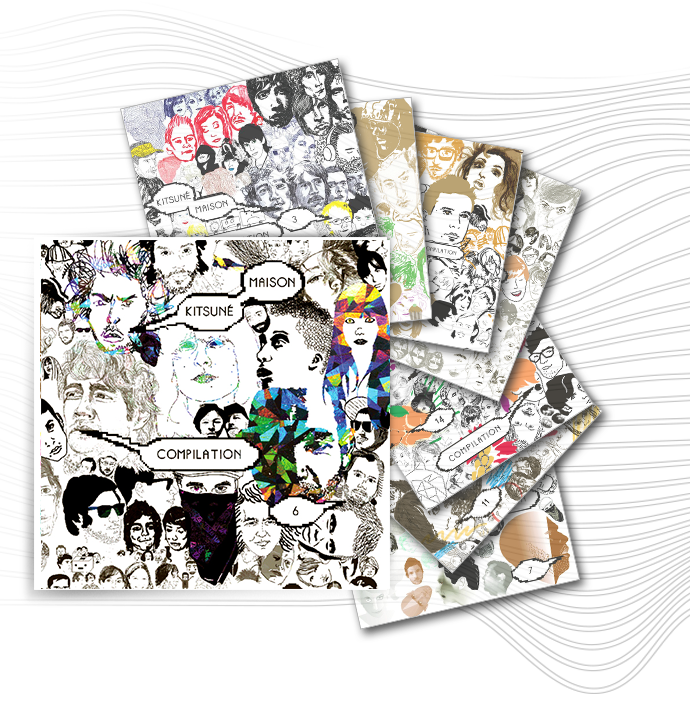
Album covers from Kitsuné Maison

For their first EP, Justice didn’t pull any punches. With its grungy bass guitars, extreme distortion, and epic disco finale, “Waters Of Nazareth” made a lasting impression because it sounded nothing like any French electronic music that had come before. The track was so strange, in fact, that some listeners sent their vinyls back to Ed Banger because they thought they were scratched.